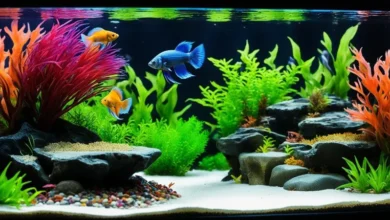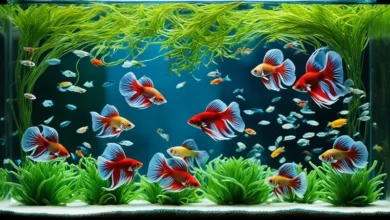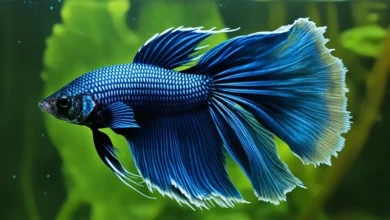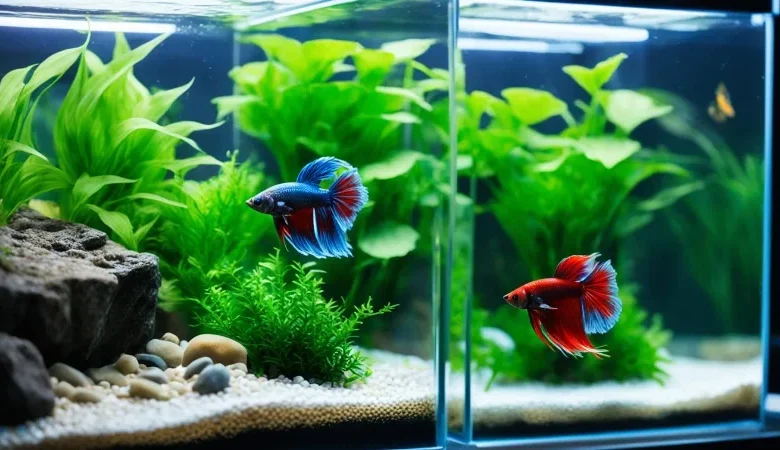
Breeding betta fish in small tanks can be a space-efficient way to breed these beautiful fish. By following certain guidelines and using the right techniques, you can successfully breed bettas in small tanks. This detailed guide will provide you with the information you need to successfully breed betta fish in small tanks.
Choosing the Right Breeding Pair
When it comes to breeding betta fish, selecting the right breeding pair is crucial for successful reproduction. To ensure the quality of your fish, look for bettas from reputable breeders who have employed selective breeding techniques. These breeders prioritize specific traits and characteristics, resulting in healthier and more desirable betta fish.
When choosing a breeding pair, consider factors such as fin size, color, and overall health. Aim for a pair that exhibits these desirable traits, as it will increase the chances of producing offspring with similar qualities.
Examining the size and fin condition of the bettas is also important. Opt for bettas with well-developed fins and a good body structure to ensure healthier offspring. Additionally, it is essential to assess compatibility between the male and female bettas. Look for signs of aggression or stress when introducing them to one another.
Responsible breeding requires considering the genetic background of the bettas and their parentage. Knowing the lineage of the fish can help you avoid potential genetic issues and maintain the overall health of the offspring.
Remember, selecting the right breeding pair sets the foundation for a successful breeding program and ensures the production of high-quality betta fish in the future.
Setting up the Breeding Tank
To breed betta fish in small tanks, it’s important to set up a suitable breeding tank. To provide enough space for the breeding process, use a tank that is at least 5-10 gallons in size. This size allows the bettas to have enough room to swim and carry out their breeding behaviors.
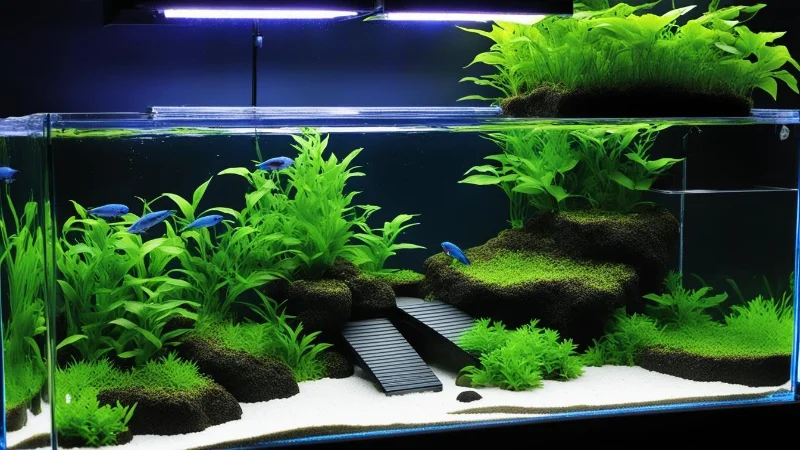
Ensure that the water quality in the breeding tank is optimal to support the health and well-being of the bettas. Use a filter to maintain clean water and regularly test and maintain the water parameters. This includes monitoring the ammonia, nitrite, and nitrate levels, as well as the pH level, to ensure they are within the appropriate range for betta fish.
Providing hiding spots and plants in the breeding tank is important, especially for the female betta. These spaces allow the female to feel safe and have areas to retreat to when needed. Additionally, having plants and decorations in the tank provides the male betta with surfaces to build his bubble nest.
The ideal water temperature for breeding betta fish is between 78 and 80 degrees Fahrenheit. Use a reliable aquarium heater to maintain a consistent temperature within this range. It’s important to avoid temperature fluctuations, as they can negatively impact the bettas’ breeding behaviors.
In summary, when setting up the breeding tank for betta fish, ensure it is of adequate size, maintain optimal water quality, provide hiding spots and plants, and maintain the appropriate water temperature. These factors create the ideal environment for successful betta breeding in small tanks.
Creating Optimal Conditions
Creating optimal conditions is crucial for successful betta fish breeding. Follow these steps to ensure the best environment for your bettas:
- Test and Adjust Water Parameters: Regularly test the water parameters, including pH, ammonia, nitrite, and nitrate levels. Make necessary adjustments to maintain high water quality, as bettas are sensitive to water conditions.
- Use a Gentle Water Filter: Install a gentle water filter in the breeding tank to maintain water quality without causing excessive water movement. The filter should provide sufficient filtration without creating strong currents that can disturb the bettas or damage the bubble nest.
- Provide Hiding Spots and Plants: Create hiding spots and add live or artificial plants to the breeding tank. These will give the female betta a sense of security, reducing stress and promoting successful breeding. They will also provide an anchor for the male’s bubble nest.
- Maintain Optimal Water Temperature: Keep the water temperature between 50 and 78 degrees Fahrenheit (10-25 degrees Celsius). This temperature range encourages betta breeding behavior and ensures the eggs and fry develop properly.
- Monitor Betta Health: Regularly observe the bettas for any signs of illness or stress. If health problems arise, provide appropriate care and treatment to maintain their well-being.
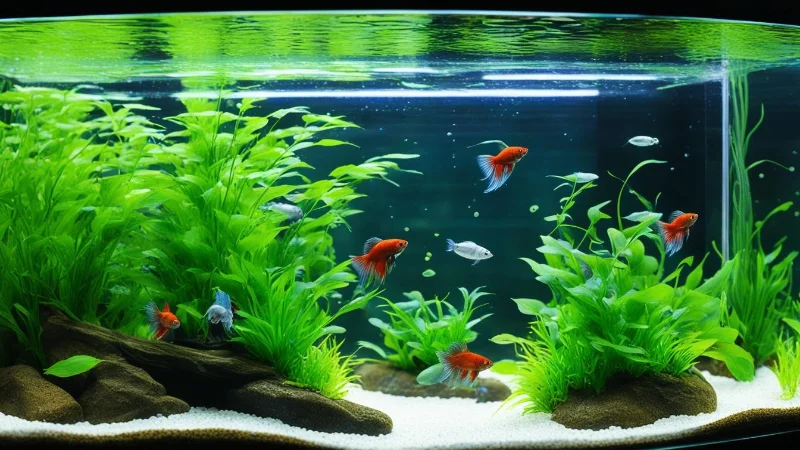
Remember, creating optimal conditions is crucial for the successful breeding of betta fish. By maintaining high water quality, providing hiding spots and plants, and monitoring betta health, you can create the perfect environment for breeding success.
Introducing the Breeding Pair
Introducing the breeding pair is a crucial step in betta fish breeding. To ensure a successful introduction, it is important to allow the male and female bettas to acclimate to their new surroundings in separate tanks. This allows them to become familiar with their environments and reduces stress.
Gradually introduce the bettas to each other by placing their tanks close together with a clear divider in between. This divider allows them to see and interact with each other while preventing direct contact. Monitor their behavior and physical changes carefully to determine when they are ready to mate.
When the male and female bettas show signs of interest and readiness, it is time to carefully move the female to the male’s tank to initiate the breeding process. This should be done with caution and in a controlled manner to minimize stress and ensure the safety of both fish.
Observing their behavior and ensuring compatibility is important during the initial introduction. This allows for a smoother breeding process and increases the chances of successful mating.
The Breeding Process
The breeding process of betta fish involves several distinct steps that are crucial for successful reproduction. Understanding these steps and providing the right conditions can greatly increase the chances of a successful breeding outcome.
First, the male betta plays a vital role in the breeding process. His primary responsibility is to build a bubble nest, which serves as a haven for the eggs and fry. The male will create the nest by blowing bubbles under an object at the water’s surface, such as a leaf or a small plant. This process involves using his mouth to blow air, creating a cluster of bubbles that forms the nest.
Once the bubble nest is complete, the male betta will start to entice the female to spawn. He will display vibrant colors, flare his fins, and perform courtship dances to attract the female’s attention. When the female is ready, she will approach the male, and the spawning act will take place. The male wraps his body around the female and releases sperm, while the female releases her eggs. These eggs will be fertilized by the male’s sperm and will eventually hatch into fry.
After the spawning act, it’s crucial to remove the female from the breeding tank as the male will become protective of his nest. The male will gather any eggs that fall from the nest and place them back into the bubble nest. He will guard the nest carefully, ensuring the eggs receive adequate oxygen and protection from predators.
Once the eggs hatch into fry, the male will continue to care for them until they can swim independently. He will provide food for the fry by releasing small particles from his mouth, which the fry will consume. It’s important to remove the male from the tank at this stage to avoid aggression towards the fry, as bettas can be territorial.
The breeding process of betta fish is a fascinating and intricate series of events that highlight the instincts of these beautiful creatures. By providing the right conditions, such as a suitable breeding tank and proper care, you can increase the chances of a successful breeding outcome and witness the wonder of new life.
Caring for the Fry
Caring for the fry is crucial for their survival and growth. As they are delicate and vulnerable, providing them with a separate tank or individual jars to grow out in is essential to ensure their safety and well-being. This allows you to control the conditions and protect them from potential harm.
When it comes to feeding the fry, it’s important to provide them with a nutritious diet that supports their healthy growth. You can feed them live or powdered fry food, which is specifically designed to meet their nutritional needs. This will ensure they receive the essential nutrients they require for optimal development.
Maintaining optimal water quality in the fry tanks is vital for their health and growth. Regularly filter the water and perform routine water changes to keep the tank conditions clean and stable. This will prevent the accumulation of waste and toxins that can be harmful to the fry.
Monitor the development of the fry closely as they grow. Regularly observe their behavior and physical characteristics to ensure they are thriving. If you notice any sick or weak fry, it’s important to remove them from the tank immediately to prevent the spread of diseases and ensure the well-being of the rest of the fry.
By providing proper care and attention to the fry, you can contribute to their successful growth and development. Remember to provide them with a separate tank or jars, feed them a nutritious diet, maintain optimal water quality, and monitor their progress closely to ensure their well-being.
Quote
- Provide a separate tank or individual jars for the fry to grow out in.
- Feed them a nutritious diet of live or powdered fried food.
- Maintain optimal water quality through filtration and regular water changes.
- Monitor their development closely and remove any sick or weak fry.
Caring for the fry requires attention to detail and a commitment to their well-being. By following these guidelines, you can help them thrive and contribute to the successful breeding of betta fish.
Conclusion
Breeding betta fish in small tanks provides a space-efficient solution for those looking to breed these vibrant and captivating fish. By implementing proper breeding techniques and creating the right conditions, you can successfully breed bettas in small tanks.
One of the key factors in successful betta fish breeding is choosing the right breeding pair. By selecting bettas with desirable traits and characteristics, such as in size, color, and overall health, you can increase the chances of producing high-quality offspring.
Setting up a suitable breeding tank is also crucial. Ensuring optimal water quality with the use of filters and maintaining an appropriate water temperature between 50 and 78 degrees Fahrenheit is essential for encouraging breeding behavior. Providing hiding spots and plants in the tank allows the female betta to feel secure and the male betta to build a bubble nest.
Introducing the breeding pair should be done gradually and with caution. Allowing the male and female bettas to acclimate to each other’s presence before initiating the breeding process can help reduce stress and aggression. Once successful mating occurs, proper care for the fry, including providing a separate tank or jars, feeding them a nutritious diet, and monitoring their development, ensures their health and growth.
In conclusion, breeding betta fish in small tanks requires patience, knowledge, and attention to detail. By following the right techniques and providing the ideal conditions, you can enjoy the gratifying experience of successfully breeding bettas in small tanks. Start your journey in betta fish breeding today and witness the beauty and wonder of these amazing creatures.

